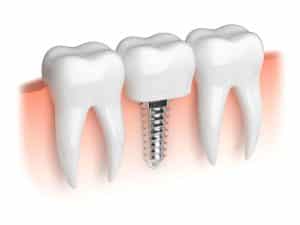A dental implant is a titanium post which replaces your tooth root. This is surgically inserted into the jawbone beneath the gum line and allows your clinician to mount a replacement tooth (crown) or a bridge to replace the missing tooth/teeth or fill gaps in your mouth. As the implants are fixed or fused with the jawbone, they don’t need to be removed daily and don’t come loose like a denture. They also do not need to be anchored to other teeth, as bridges do, and so do not compromise the oral health of the other teeth.
Standard dental implants range from about 3mm to 6mm in width and from about 6mm to 15mm in length. Before implants are considered, you must have healthy gums and adequate bone. If your bone is too thin, you may require a bone graft in order to support the implant.
Procedure for standard dental implants
A periodontist carries out the surgical procedure to place the titanium fixture, or post, into the bone of the jaw. Once the fixture is fused with the bone, a process that takes about three months, a small abutment or post is attached to the implant and acts as an anchor for an artificial tooth, or crown, to be attached.

Mini dental implants
Mini dental implants have the same structure as regular implants but are much smaller. Mini implants are about 1.8mm to 2.9mm in diameter and 10mm to 18mm long. They are suitable for patients who may have lost too much bone width in the jaws to receive regular-sized implants.
Mini implants versus standard dental implants
Standard dental implants have been designed to mimic the natural root form in order to support the artificial tooth (crown) so that it resembles a natural tooth as the crown sits on the gum. A mini dental implant, by virtue of its smaller diameter, may not support the gum tissue as well as a standard dental implant. Standard dental implants have also been designed to support the load placed on the artificial tooth or crown during chewing, while the smaller diameter implants may not be strong enough to support the load, especially in patients with a strong bite. Hence, mini dental implants are more prone to break or fracture. In order to compensate for this, multiple mini dental implants may need to be placed to support some attachments, such as bridges.
Studies have shown that we need to keep our “new teeth” clean, just like natural teeth. As standard dental implants have been extensively researched and designed to resemble natural tooth, they are easier to keep clean than mini dental implants. Mini implants have a relatively large crown sitting on the narrower “root”, creating areas for the potential accumulation of plaque or food, which is difficult to reach during brushing.
Considering the long-term cost–benefit ratio, standard dental implants may be the first line of choice in replacing missing teeth, especially in patients with sufficient bone volume. However, in any patient where bone width is lacking and who is not a candidate for bone grafting to rebuild the bone, mini dental implants may be considered.
